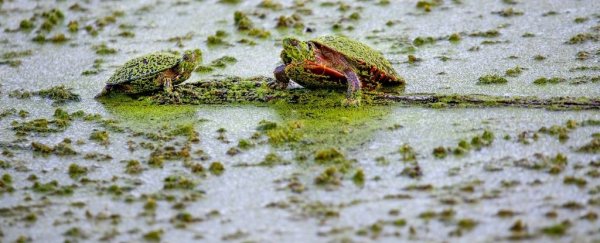Apart from the global catastrophe that killed off most of the dinosaurs, some experts think almost all the mass extinctions in Earth's history were followed by a proliferation of microbes in rivers and lakes.
After the Permian extinction event 252 million years ago – the largest mass extinction event in Earth's history – there appears to have been a burst in bacterial and algal blooms, lasting for hundreds of thousands of years.
According to the geologic record in Australia, the damaging impacts of climate change and climate-driven deforestation during the Permian extinction event most likely caused a toxic soup to sprout in the Sydney Basin, one of the oldest known freshwater ecosystems in the world.
That's disconcerting, the authors say, as human activity is leading to a similar mass extinction event today.
"We're seeing more and more toxic algae blooms in lakes and in shallow marine environments that's related to increases in temperature and changes in plant communities which are leading to increases in nutrient contributions to freshwater environments," says geologist Tracy Frank from the University of Connecticut
"So, a lot of parallels to today. The volcanism was a source of CO2 in the past, but we know that the rate of CO2 input that was seen back then was similar to the rate of CO2 increases we're seeing today because of anthropogenic effects."
Algae and bacteria are normal parts of a healthy freshwater environment, but sometimes they can grow out of control and deplete the water of oxygen, creating 'dead zones'.
This tends to happen with global warming, deforestation, and the rush of soil nutrients into waterways, which can feed microbes. All three of these factors are in play today, which is why we are probably seeing increases in toxic blooms already.
Considering what's happened in the past, that's a disturbing sign.
According to soil, fossil, and geochemical data from the Sydney Basin, researchers think the spread of microbes in the wake of the Permian extinction "was both a symptom of continental ecosystem collapse, and a cause of its delayed recovery."
Volcanic eruptions in the Permian first triggered an accelerated and sustained rise in greenhouse gas emissions. This caused higher global temperatures and sudden deforestation due to wildfires or drought.
Once the trees were gone, it wasn't long before the structure of the soil began to erode, and its nutrients slipped into freshwater ecosystems.
For more than three million years, Earth's forests struggled to recover. The Sydney Basin was instead littered with lowland ecosystems that "were regularly inundated by stagnant, fresh/brackish waterbodies hosting thriving algal and bacterial populations", the authors write.
In turn, these persistent dead zones prevented the reestablishment of important carbon sinks, like peatlands, and slowed down climate and ecosystem recovery.
Other deep-time records around the world have also found microbial blooms are common after warming-driven extinction events. The exception seems to be the very large asteroid event that caused the mass extinction of dinosaurs 66 million years ago.
This major episode caused vast amounts of dust and sulfate aerosols to rise into the atmosphere, but compared to volcanic activity, the meteorite only caused a modest increase in atmospheric carbon dioxide and temperature, not a sustained one. As such, freshwater microbes only seemed to undergo a short-lived burst after the extinction event.
Unfortunately, that's very different from what occurred during the Permian extinction and what is happening today.
For instance, the researchers note that the "optimal temperature growth range" of these harmful algae in freshwater environments is 20-32 °C (68-89.6 °F). That range matches the estimated continental summer surface air temperatures for the region during the early Triassic. That range is what's projected for mid-latitude continental summer surface air temperatures in 2100.
Scientists are noticing other similarities, including an increase in forest fires and the subsequent destabilization of soils.
"The other big parallel is that the increase in temperature at the end of the Permian coincided with massive increases in forest fires," says geologist Chris Fielding, also from the University of Connecticut.
"One of the things that destroyed whole ecosystems was fire, and we're seeing that right now in places like California. One wonders what the longer-term consequences of events like that as they are becoming more and more widespread."
The good news is that this time many of the changes are in our control. The bad news is that whatever happens next is our own fault.
"The end-Permian mass extinction event took four million years to recover from," Fielding says. "That's sobering."
The study was published in Nature Communications.
